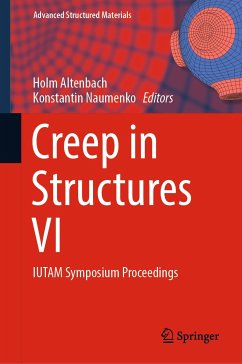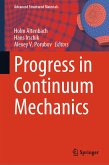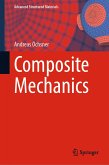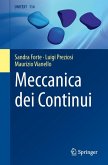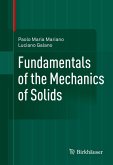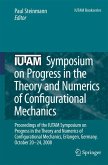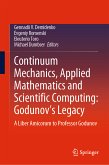Creep in Structures VI (eBook, PDF)
IUTAM Symposium Proceedings
181,89 €
inkl. MwSt.
Sofort per Download lieferbar

0 °P sammeln
Creep in Structures VI (eBook, PDF)
IUTAM Symposium Proceedings
- Format: PDF
- Merkliste
- Auf die Merkliste
- Bewerten Bewerten
- Teilen
- Produkt teilen
- Produkterinnerung
- Produkterinnerung

Bitte loggen Sie sich zunächst in Ihr Kundenkonto ein oder registrieren Sie sich bei
bücher.de, um das eBook-Abo tolino select nutzen zu können.
Hier können Sie sich einloggen
Hier können Sie sich einloggen
Sie sind bereits eingeloggt. Klicken Sie auf 2. tolino select Abo, um fortzufahren.

Bitte loggen Sie sich zunächst in Ihr Kundenkonto ein oder registrieren Sie sich bei bücher.de, um das eBook-Abo tolino select nutzen zu können.
This book offers a current state of the art in analysis and modeling of creep phenomena with applications to the structural mechanics. It presents the some presentations from the IUTAM-Symposium series "Creep in Structures", which held in Magdeburg (Germany) in September 2023, and it discusses many advances and new results in the field. These are for example: interlinks of mechanics with materials science in multi-scale analysis of deformation and damage mechanisms over a wide range of stresses and temperature; development and analysis of new alloys for (ultra)high-temperature applications;…mehr
- Geräte: PC
- ohne Kopierschutz
- eBook Hilfe
- Größe: 31.64MB
- Upload möglich
Andere Kunden interessierten sich auch für
![Progress in Continuum Mechanics (eBook, PDF) Progress in Continuum Mechanics (eBook, PDF)]() Progress in Continuum Mechanics (eBook, PDF)128,39 €
Progress in Continuum Mechanics (eBook, PDF)128,39 €![Composite Mechanics (eBook, PDF) Composite Mechanics (eBook, PDF)]() Andreas ÖchsnerComposite Mechanics (eBook, PDF)106,99 €
Andreas ÖchsnerComposite Mechanics (eBook, PDF)106,99 €![Meccanica dei Continui (eBook, PDF) Meccanica dei Continui (eBook, PDF)]() Sandra ForteMeccanica dei Continui (eBook, PDF)23,95 €
Sandra ForteMeccanica dei Continui (eBook, PDF)23,95 €![Will We Ever Have a Quantum Computer? (eBook, PDF) Will We Ever Have a Quantum Computer? (eBook, PDF)]() Mikhail I. DyakonovWill We Ever Have a Quantum Computer? (eBook, PDF)57,95 €
Mikhail I. DyakonovWill We Ever Have a Quantum Computer? (eBook, PDF)57,95 €![Fundamentals of the Mechanics of Solids (eBook, PDF) Fundamentals of the Mechanics of Solids (eBook, PDF)]() Paolo Maria MarianoFundamentals of the Mechanics of Solids (eBook, PDF)40,95 €
Paolo Maria MarianoFundamentals of the Mechanics of Solids (eBook, PDF)40,95 €![IUTAM Symposium on Progress in the Theory and Numerics of Configurational Mechanics (eBook, PDF) IUTAM Symposium on Progress in the Theory and Numerics of Configurational Mechanics (eBook, PDF)]() IUTAM Symposium on Progress in the Theory and Numerics of Configurational Mechanics (eBook, PDF)73,95 €
IUTAM Symposium on Progress in the Theory and Numerics of Configurational Mechanics (eBook, PDF)73,95 €![Continuum Mechanics, Applied Mathematics and Scientific Computing: Godunov's Legacy (eBook, PDF) Continuum Mechanics, Applied Mathematics and Scientific Computing: Godunov's Legacy (eBook, PDF)]() Continuum Mechanics, Applied Mathematics and Scientific Computing: Godunov's Legacy (eBook, PDF)73,95 €
Continuum Mechanics, Applied Mathematics and Scientific Computing: Godunov's Legacy (eBook, PDF)73,95 €-
-
-
This book offers a current state of the art in analysis and modeling of creep phenomena with applications to the structural mechanics. It presents the some presentations from the IUTAM-Symposium series "Creep in Structures", which held in Magdeburg (Germany) in September 2023, and it discusses many advances and new results in the field. These are for example: interlinks of mechanics with materials science in multi-scale analysis of deformation and damage mechanisms over a wide range of stresses and temperature; development and analysis of new alloys for (ultra)high-temperature applications; formulation and calibration of advanced constitutive models of inelastic behavior under transient loading and temperature conditions; development of efficient procedures and machine learning techniques for identification of material parameters in advanced constitutive laws; introduction of gradient-enhanced and non-local theories to account for damage and fracture processes; and applicationof new experimental methods, such as digital image correlation, for the analysis of inelastic deformation under multi-axial stress state.
Produktdetails
- Produktdetails
- Verlag: Springer Nature Switzerland
- Erscheinungstermin: 4. August 2023
- Englisch
- ISBN-13: 9783031390708
- Artikelnr.: 68538676
- Verlag: Springer Nature Switzerland
- Erscheinungstermin: 4. August 2023
- Englisch
- ISBN-13: 9783031390708
- Artikelnr.: 68538676
- Herstellerkennzeichnung Die Herstellerinformationen sind derzeit nicht verfügbar.
Chapter 1: Phase-Field Damage Modeling in Generalized Mechanics by using a Mixed Finite Element Method (FEM).- Chapter 2: Creep-Damage Processes in Cyclic Loaded Double Walled Structures.- Chapter 3: Creep Mechanics – Some Historical Remarks and New Trends.- Chapter 4: Various State-of-the-Art Methods for Creep Evaluation of Power Plant Components in a Wide Load and Temperature Range.- Chapter 5: Creep and Irradiation Effects in Reactor Vessel Internals.- Chapter 6: Analysis of Damage and Fracture in Anisotropic Sheet Metals Based on Biaxial Experiments.- Chapter 7: Effect of Physical Aging on the Flexural Creep in 3D Printed Thermoplastic.- Chapter 8: Development of a Microstructure-Based Finite Element Model of Thermomechanical Response of a Fully Metallic Composite Phase Change Material.- Chapter 9: The Effect of Dynamic Loads on the Creep of Geomaterials.- Chapter 10: A Novel Simulation Method for Phase Transition of Single Crystal Ni based Superalloys in Elevated Temperature Creep Regions via Discrete Cosine Transform and Maximum Entropy Method.- Chapter 11: Anisotropic Creep Analysis of Fiber Reinforced Load Point Support Structures for Thermoplastic Sandwich Panels.- Chapter 12: Time-Swelling Superposition Principle for the Linear Viscoelastic Properties of Polyacrylamide Hydrogels.- Chapter 13: Application of Nonlinear Viscoelastic Material Models for the Shrinkage and Warpage Analysis of Blow Molded Parts.- Chapter 14: Modeling Solid Materials in DEM Using the Micropolar Theory.- Chapter 15: The Development of a Cavitation-Based Model for Creep Lifetime Prediction Using Cu-40Zn-2Pb Material.- Chapter 16: Self-heating Analysis with Respect to Holding Times of an Additive Manufactured Aluminium Alloy.- Chapter 17: Creep Under High Temperature Thermal Cycling and Low Mechanical Loadings.- Chapter 18: The Development and Application of Optimisation Technique for the Calibrating of Creep Cavitation Model Based on Cavity Histogram.- Chapter 19: A Temperature-Dependent Viscoelastic Approach to the Constitutive Behavior of Semi-Crystalline Thermoplastics at Finite Deformations.
Chapter 1: Phase-Field Damage Modeling in Generalized Mechanics by using a Mixed Finite Element Method (FEM).- Chapter 2: Creep-Damage Processes in Cyclic Loaded Double Walled Structures.- Chapter 3: Creep Mechanics - Some Historical Remarks and New Trends.- Chapter 4: Various State-of-the-Art Methods for Creep Evaluation of Power Plant Components in a Wide Load and Temperature Range.- Chapter 5: Creep and Irradiation Effects in Reactor Vessel Internals.- Chapter 6: Analysis of Damage and Fracture in Anisotropic Sheet Metals Based on Biaxial Experiments.- Chapter 7: Effect of Physical Aging on the Flexural Creep in 3D Printed Thermoplastic.- Chapter 8: Development of a Microstructure-Based Finite Element Model of Thermomechanical Response of a Fully Metallic Composite Phase Change Material.- Chapter 9: The Effect of Dynamic Loads on the Creep of Geomaterials.- Chapter 10: A Novel Simulation Method for Phase Transition of Single Crystal Ni based Superalloys in Elevated Temperature Creep Regions via Discrete Cosine Transform and Maximum Entropy Method.- Chapter 11: Anisotropic Creep Analysis of Fiber Reinforced Load Point Support Structures for Thermoplastic Sandwich Panels.- Chapter 12: Time-Swelling Superposition Principle for the Linear Viscoelastic Properties of Polyacrylamide Hydrogels.- Chapter 13: Application of Nonlinear Viscoelastic Material Models for the Shrinkage and Warpage Analysis of Blow Molded Parts.- Chapter 14: Modeling Solid Materials in DEM Using the Micropolar Theory.- Chapter 15: The Development of a Cavitation-Based Model for Creep Lifetime Prediction Using Cu-40Zn-2Pb Material.- Chapter 16: Self-heating Analysis with Respect to Holding Times of an Additive Manufactured Aluminium Alloy.- Chapter 17: Creep Under High Temperature Thermal Cycling and Low Mechanical Loadings.- Chapter 18: The Development and Application of Optimisation Technique for the Calibrating of Creep Cavitation Model Based on Cavity Histogram.- Chapter 19: A Temperature-Dependent Viscoelastic Approach to the Constitutive Behavior of Semi-Crystalline Thermoplastics at Finite Deformations.
Chapter 1: Phase-Field Damage Modeling in Generalized Mechanics by using a Mixed Finite Element Method (FEM).- Chapter 2: Creep-Damage Processes in Cyclic Loaded Double Walled Structures.- Chapter 3: Creep Mechanics – Some Historical Remarks and New Trends.- Chapter 4: Various State-of-the-Art Methods for Creep Evaluation of Power Plant Components in a Wide Load and Temperature Range.- Chapter 5: Creep and Irradiation Effects in Reactor Vessel Internals.- Chapter 6: Analysis of Damage and Fracture in Anisotropic Sheet Metals Based on Biaxial Experiments.- Chapter 7: Effect of Physical Aging on the Flexural Creep in 3D Printed Thermoplastic.- Chapter 8: Development of a Microstructure-Based Finite Element Model of Thermomechanical Response of a Fully Metallic Composite Phase Change Material.- Chapter 9: The Effect of Dynamic Loads on the Creep of Geomaterials.- Chapter 10: A Novel Simulation Method for Phase Transition of Single Crystal Ni based Superalloys in Elevated Temperature Creep Regions via Discrete Cosine Transform and Maximum Entropy Method.- Chapter 11: Anisotropic Creep Analysis of Fiber Reinforced Load Point Support Structures for Thermoplastic Sandwich Panels.- Chapter 12: Time-Swelling Superposition Principle for the Linear Viscoelastic Properties of Polyacrylamide Hydrogels.- Chapter 13: Application of Nonlinear Viscoelastic Material Models for the Shrinkage and Warpage Analysis of Blow Molded Parts.- Chapter 14: Modeling Solid Materials in DEM Using the Micropolar Theory.- Chapter 15: The Development of a Cavitation-Based Model for Creep Lifetime Prediction Using Cu-40Zn-2Pb Material.- Chapter 16: Self-heating Analysis with Respect to Holding Times of an Additive Manufactured Aluminium Alloy.- Chapter 17: Creep Under High Temperature Thermal Cycling and Low Mechanical Loadings.- Chapter 18: The Development and Application of Optimisation Technique for the Calibrating of Creep Cavitation Model Based on Cavity Histogram.- Chapter 19: A Temperature-Dependent Viscoelastic Approach to the Constitutive Behavior of Semi-Crystalline Thermoplastics at Finite Deformations.
Chapter 1: Phase-Field Damage Modeling in Generalized Mechanics by using a Mixed Finite Element Method (FEM).- Chapter 2: Creep-Damage Processes in Cyclic Loaded Double Walled Structures.- Chapter 3: Creep Mechanics - Some Historical Remarks and New Trends.- Chapter 4: Various State-of-the-Art Methods for Creep Evaluation of Power Plant Components in a Wide Load and Temperature Range.- Chapter 5: Creep and Irradiation Effects in Reactor Vessel Internals.- Chapter 6: Analysis of Damage and Fracture in Anisotropic Sheet Metals Based on Biaxial Experiments.- Chapter 7: Effect of Physical Aging on the Flexural Creep in 3D Printed Thermoplastic.- Chapter 8: Development of a Microstructure-Based Finite Element Model of Thermomechanical Response of a Fully Metallic Composite Phase Change Material.- Chapter 9: The Effect of Dynamic Loads on the Creep of Geomaterials.- Chapter 10: A Novel Simulation Method for Phase Transition of Single Crystal Ni based Superalloys in Elevated Temperature Creep Regions via Discrete Cosine Transform and Maximum Entropy Method.- Chapter 11: Anisotropic Creep Analysis of Fiber Reinforced Load Point Support Structures for Thermoplastic Sandwich Panels.- Chapter 12: Time-Swelling Superposition Principle for the Linear Viscoelastic Properties of Polyacrylamide Hydrogels.- Chapter 13: Application of Nonlinear Viscoelastic Material Models for the Shrinkage and Warpage Analysis of Blow Molded Parts.- Chapter 14: Modeling Solid Materials in DEM Using the Micropolar Theory.- Chapter 15: The Development of a Cavitation-Based Model for Creep Lifetime Prediction Using Cu-40Zn-2Pb Material.- Chapter 16: Self-heating Analysis with Respect to Holding Times of an Additive Manufactured Aluminium Alloy.- Chapter 17: Creep Under High Temperature Thermal Cycling and Low Mechanical Loadings.- Chapter 18: The Development and Application of Optimisation Technique for the Calibrating of Creep Cavitation Model Based on Cavity Histogram.- Chapter 19: A Temperature-Dependent Viscoelastic Approach to the Constitutive Behavior of Semi-Crystalline Thermoplastics at Finite Deformations.
